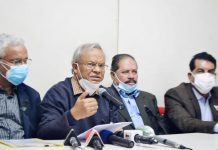Dr. Iftekhar Muhsin
Bangladesh ranks among the top tobacco-consuming nations globally, with 35.3 percent of its adult population using tobacco. The Global Burden of Disease Study – 2019 highlights tobacco as one of the primary causes of death and disability in the country, with 161,000 people succumbing to tobacco-related diseases annually. The detrimental effects of tobacco extend beyond the mere consumption of tobacco products; they encompass the entire production process, from cultivation to processing. This comprehensive impact inflicts significant socio-economic harm on the nation, posing a major obstacle to the attainment of Sustainable Development Goals (SDG-30). A holistic examination of the tobacco production system reveals that both tobacco consumption and cultivation, along with processing, present formidable challenges to the realization of Sustainable Development Goals.
Tobacco cultivation in Bangladesh is on the rise, particularly in the north-eastern region where it’s expanding rapidly, encroaching upon vital agricultural land like Chalanbil, known as the food bank of the northern region. The encroachment of tobacco cultivation into Hill Tracts areas is also evident. According to the Agricultural Statistics Yearbook-2021, approximately one lakh acres of land are dedicated to tobacco cultivation across the country, a figure likely to be even higher. If this land were utilized for other crops like Boro paddy, wheat, or potatoes, significant yields could have been achieved. For instance, planting Boro paddy on this land could have resulted in 1,67,428 metric tons of Boro, while wheat and potato cultivation could have yielded 1,32,966 metric tons and 8,50,387 metric tons respectively. The loss incurred due to tobacco cultivation amounts to around 31 thousand crores. Moreover, nearly 90 percent of the land in Bandarban of Chittagong Hill Tracts is currently under cultivation, leading to food shortages attributed to excessive tobacco farming. Agricultural economists warn that if this trend persists, it will jeopardize the country’s food security and sustainable agriculture goals.
Women and children, particularly in hilly areas, are heavily involved in these activities. Women, in particular, bear the brunt of labor in tobacco cultivation. Farmers, workers, women, and children face numerous health risks throughout the process. Women and children are often engaged in tasks like drying and burning tobacco leaves, exposing them to continuous health hazards. Consequently, health issues are prevalent in tobacco-growing regions, particularly among pregnant women who experience a range of health complications, including giving birth to handicapped children, abortions, and low birth weights. Disability rates are higher in these areas. Additionally, children are susceptible to various diseases from a young age. Studies have identified widespread instances of Berger’s and Green Tobacco Sickness among tobacco farmers and their families. Moreover, the use of pesticides and chemical fertilizers in tobacco fields has detrimental effects on aquatic life, livestock, and vegetable production. This leads to a decline in biodiversity, disrupts nutrient cycles, and contributes to malnutrition among both adults and children. Such long-term health implications pose significant barriers to achieving the Sustainable Development Goals, particularly those related to promoting good health.
Tobacco cultivation significantly diminishes land fertility over time, rendering it incapable of sustaining other crops. Consequently, impoverished farmers find themselves trapped in a vicious cycle of tobacco farming, leading to further impoverishment. The detrimental effects extend beyond land fertility; farmers’ health deteriorates, medical expenses soar, children abandon education, and women and children suffer from severe health issues with intergenerational consequences. Simultaneously, tobacco cultivation inflicts substantial economic and environmental damage, exacerbating poverty. Notably, the poorest districts of Kurigram, Gaibandha, Nilphamari, Rangpur, Bandarban, and Khagrachari are among the top tobacco-cultivating areas, exacerbating financial crises for families due to the medical costs associated with tobacco-related diseases. Research indicates that millions are pushed into poverty annually due to these expenses, predominantly stemming from non-communicable diseases related to tobacco use. The economic burden of tobacco uses in the country amounts to Tk 30 thousand 500 crores. In essence, tobacco cultivation perpetuates poverty, undermining efforts aimed at poverty eradication, a primary goal of the Sustainable Development Goals (SDGs).
Tobacco farming and processing activities not only impede progress towards achieving gender equality, a key sustainable development goal, but also perpetuate discrimination against women. Women engaged in tobacco cultivation and production endure unfair treatment in terms of wages, often working long hours in harsh conditions without receiving adequate compensation. Moreover, many women suffer from indirect smoking exposure, further exacerbating gender disparities in health and well-being.
Furthermore, tobacco cultivation and its production processes inflict significant harm on the environment and biodiversity across all districts where tobacco is grown. Deforestation, amounting to 30% in Bangladesh, is attributed to tobacco burning and land clearance for cultivation and processing. Each year, an alarming number of trees—29 lakh 32 thousand—are burned solely for tobacco processing, while extensive wood consumption, approximately 5 tons per acre of land, is required for drying tobacco. Additionally, the widespread use of pesticides and chemicals in tobacco farming continues to devastate biodiversity, adversely affecting fauna and flora. In hilly areas, tobacco cultivation along water canals further exacerbates environmental degradation, posing risks to the entire ecosystem and exacerbating climate change, a critical sustainable development goal. Furthermore, the accumulation of cigarette packets, filters, and other tobacco residues in aquatic environments poses a significant threat to marine life, highlighting the detrimental impact of tobacco cultivation and consumption on the environment.
Tobacco cultivation, processing, production, marketing and consumption of tobacco products are acting as major barriers to achieving the Sustainable Development Goals. To achieve sustainable development goals in Bangladesh such as poverty alleviation, ensuring food security, good health, environmental protection and other goals, we need to control tobacco. When it comes to tobacco control, tobacco cultivation must also be controlled along with tobacco consumption. Bangladesh has been cultivating tobacco for 40-50 years. Its downside is proven by research. Therefore, tobacco control laws should be strengthened in the light of FCTC to build a tobacco-free Bangladesh. Prices of all tobacco products including cigarettes should be increased and policies should be formulated and implemented to discourage tobacco cultivation. Through this strong framework we will be able to achieve the Sustainable Development Goals.
Author: Dr. Iftekhar Muhsin
Public Health Specialist
Project Coordinator, Shastho Shurokkha Foundation














